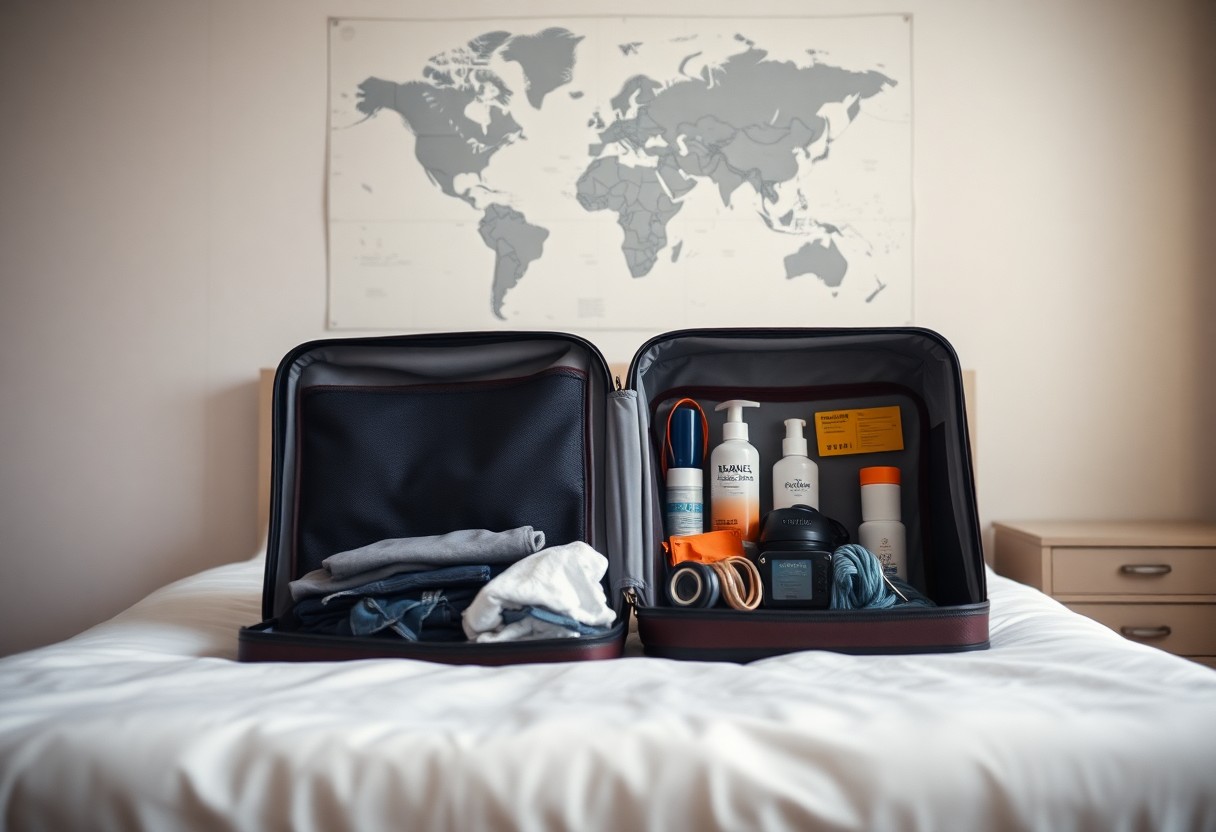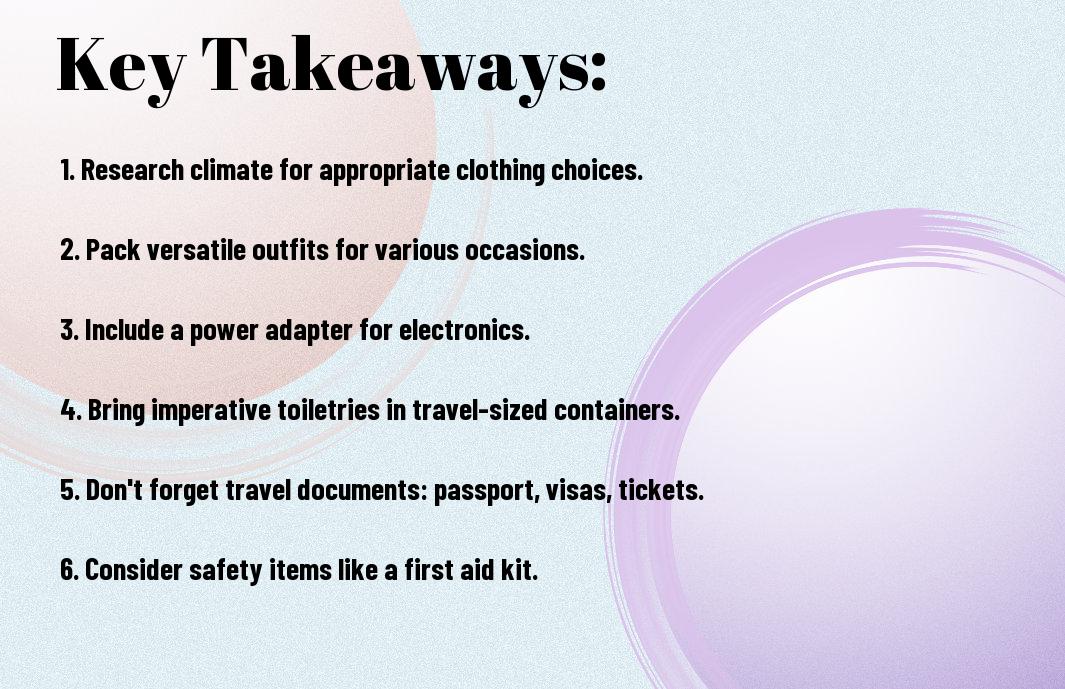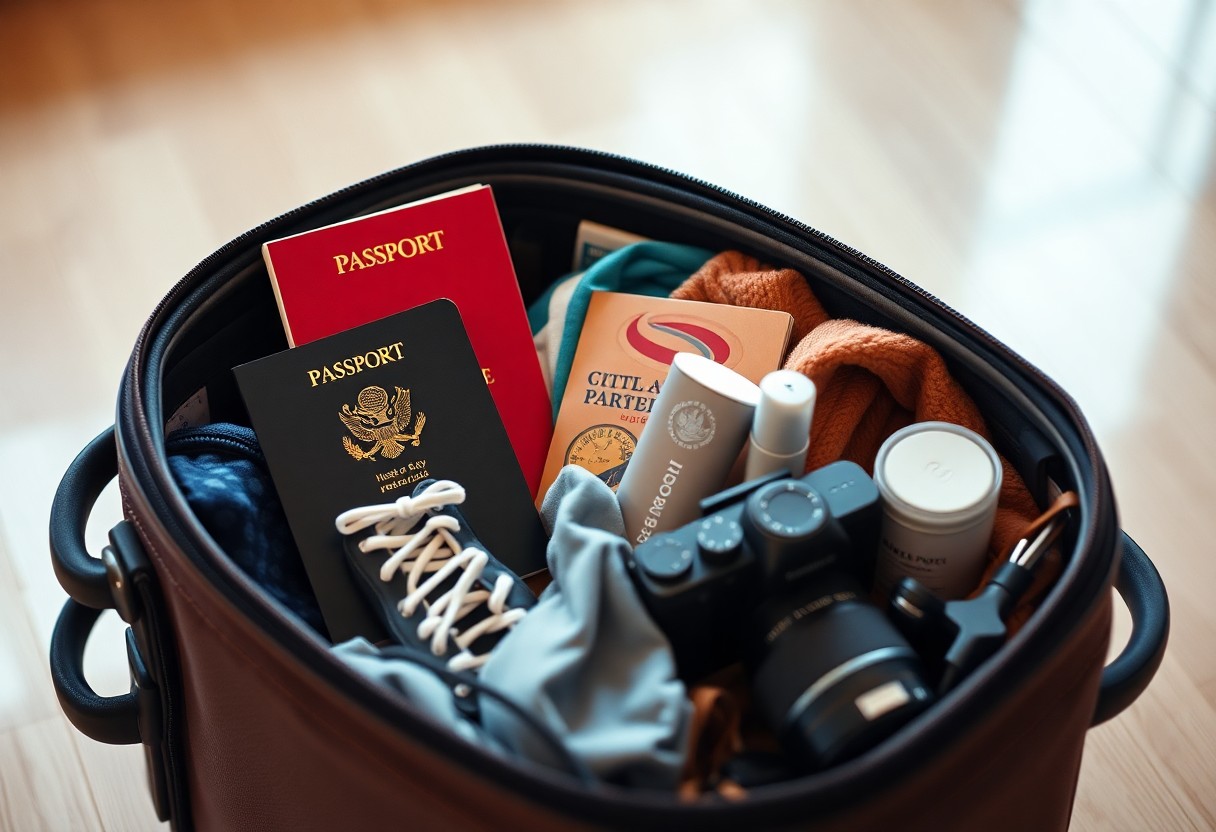Many travelers find themselves struggling with the challenge of packing efficiently for international trips. You want to make the most of your journey without being weighed down by excess baggage. In this guide, you’ll learn practical tips and strategies to streamline your packing process, ensuring you have everything you need while keeping your load light and manageable. With the right approach, you can enjoy your travels more freely and comfortably.

Key Takeaways:
- Plan: Create a detailed itinerary to determine necessarys and avoid unnecessary items.
- Versatile Clothing: Opt for clothes that can be mixed and matched and serve multiple purposes.
- Travel-sized Essentials: Use travel-sized containers for toiletries and pack only what you need to save space.
- Layering: Pack layers instead of bulky items, especially for varying climates.
- Limit Footwear: Choose two pairs of comfortable shoes that work for all occasions to minimize bulk.

Understanding the Essentials
While traveling internationally, it’s vital to focus on the items you truly need. This means prioritizing versatile clothing, limited footwear, and vital toiletries that align with your itinerary and activities. By honing in on these vitals, you can maximize space in your luggage and minimize the stress of overpacking.
Identifying Key Factors for Packing Light
Packing light starts with understanding what you’ll need for your trip. Identifying key factors can simplify the process:
- Your destination’s climate and culture
- Duration of your trip
- Activities planned
- Available laundry facilities
- Travel style and preferences
Recognizing these factors helps tailor your packing strategy more effectively.
Determining the Duration and Destination
Clearly defining the duration and destination of your trip is vital in guiding your packing choices. This ensures you select appropriate clothing and gear suited to your travel context.
For instance, a week-long adventure in a warm climate will require different clothing compared to a month-long excursion through varying weather. Consider whether you will have access to laundry services, as this can allow you to pack fewer items while still bringing enough to stay comfortable and stylish. Tailoring your packing list based on these factors prevents you from bringing unnecessary items and encourages a more minimalist approach.
How-To: Create a Packing List
Clearly, creating a packing list is the first step towards a successful minimalist travel experience. Begin by jotting down everything you think you’ll need, focusing on crucials and eliminating items that are rarely used. For more detailed guidance, check out Packing Smart and Traveling Light. This process not only helps you visualize your needs but also aids in avoiding overpacking and ensuring that you have everything necessary for a fantastic international trip.
Categorizing Items for Efficiency
HowTo categorize your packing list into groups such as clothing, toiletries, and electronics. This method not only streamlines the packing process but also allows you to prioritize what you truly need for your journey. By seeing everything laid out, you can efficiently identify any redundancies and optimize space in your luggage, making for a smoother travel experience.
Prioritizing Versatile Clothing
To maximize your packing precision, prioritize versatile clothing that can serve multiple purposes. Look for pieces that can easily be dressed up or down, such as neutral tops that pair well with various bottoms. This approach not only reduces the number of clothing items you pack but also allows for flexibility in your travel wardrobe.
Create a capsule wardrobe by selecting versatile pieces that mix and match easily. Opt for items made from lightweight materials that dry quickly, allowing for easy washing on the go. Remember to include layers, such as a lightweight jacket or scarf, which can adapt to varying climates. Furthermore, consider functions like pockets or packable outfits, which elevate your travel experience while maintaining a light load.
Tips for Clothing Selection
Unlike packing heavy items, selecting your clothing wisely can significantly lighten your load. Focus on versatile pieces that can be mixed and matched while considering the climate at your destination. Here are some tips to help you choose:
- Pick neutral colors for easy coordination.
- Select wrinkle-resistant fabrics.
- Avoid bulkiness; opt for thin layers instead.
- Limit footwear to two pairs, one casual and one dressy.
- Plan outfits based on activities and occasions.
Any item you take should serve multiple purposes or occasions.
Choosing Lightweight Fabrics
One way to keep your suitcase lightweight is by opting for breathable, lightweight fabrics. Materials like cotton, linen, and moisture-wicking synthetics dry quickly and take up less space. Avoid heavy fabrics like denim or wool, as they add unnecessary weight and bulk to your baggage, making it harder for you to move around comfortably.
Strategies for Layering
Even on a trip with varying temperatures, layering can help you maximize your clothing options without extra bulk. By wearing multiple thin layers, you can adapt to different climates and activities on the go.
A key advantage of layering is versatility. Start with a moisture-wicking base layer to keep you dry, add an insulating mid-layer for warmth, and top it with a lightweight, weather-resistant jacket. This way, you can easily adjust your outfit as temperatures change throughout the day or during different activities, allowing you to travel light without sacrificing comfort or style. Aim to select pieces that complement each other to create multiple outfits with fewer items.
How-To: Optimize Your Luggage
After selecting the right tools for your trip, it’s time to optimize your luggage for maximum efficiency. Consider the size and type of your luggage, making sure it meets airline regulations and suits your travel needs. A well-structured packing strategy can significantly reduce stress, leaving more room for your treasured souvenirs.
Selecting the Right Luggage Type
HowTo choose the right luggage type involves assessing your travel style and duration. Opt for a durable wheeled suitcase for longer trips, while a compact backpack may suit short excursions better. Lightweight materials and smart compartments enhance mobility, making your journey hassle-free.
Mastering Packing Techniques
One effective way to pack light is to adopt specific techniques that maximize space and organization. Utilizing folding methods like the roll technique or using packing cubes can help you fit more into your bag while keeping items tidy and accessible.
With a few strategic packing methods, you’ll find it easier to maintain organization and efficiently use space in your luggage. Start by rolling your clothes instead of folding, which reduces wrinkles and saves space. Incorporate packing cubes to categorize your belongings, making it easy to locate imperatives without rummaging through your entire bag. By layering shoes and utilizing the empty spaces in your bags, you can make the most of every inch, ensuring you have everything you need without overpacking.
Tips for Minimized Toiletries
Now, packing light is easier when you minimize your toiletries. Here are some effective tips:
- Choose travel-size products or repurpose sample sizes.
- Research hotels for complimentary toiletries to lighten your load.
- Utilize a single bag or organizer for all your personal care items.
- Prioritize crucials and leave non-crucials behind.
The right strategies can help you avoid overpacking.
Utilizing Travel-Size Containers
The best way to lighten your toiletries is by utilizing travel-size containers. These small bottles allow you to bring only what you need while adhering to airline restrictions. You can easily find containers from various stores, or you can decant your favorite products into reusable mini bottles. This approach not only saves space but also prevents you from carrying bulky original containers.
Combining Products for Multi-Use
Clearly, combining products for multi-use can significantly simplify your packing. Multi-purpose items can serve various functions, reducing the number of toiletries you need to bring.
A great example of combining products is using a moisturizer that doubles as a sunscreen, or a shampoo that also acts as a body wash. Look for multifunctional beauty products that can help you minimize your packing while maintaining your self-care routine. By ensuring your items can do double duty, you free up valuable space and make your travel experience even more convenient.
How-To: Prepare for Security and Travel Restrictions
Not knowing the latest security measures and travel restrictions can lead to unnecessary stress at the airport. Always check for any updates before your trip, as policies can vary by destination and may change frequently. Pack your belongings in a way that allows for easy access to your electronics and liquids, as these often require separate screening. Being well-prepared will streamline your security experience and help ensure you start your journey on the right foot.
Understanding Airline Regulations
There’s a lot to consider when it comes to airline regulations, especially regarding baggage size, weight limits, and prohibited items. Each airline has specific rules that you must follow, so it’s important to check these guidelines directly on the airline’s website before you pack. Adhering to these regulations will not only save you from potential extra fees but also make your travel experience smoother.
Navigating Customs Requirements
HowTo ensure a hassle-free experience when crossing borders is to be aware of customs requirements for your destination. Each country has its own rules regarding what you can bring into the country, so familiarize yourself with these restrictions in advance.
Airline travel often involves navigating a host of customs regulations that can influence what you pack. Many countries impose strict limits on items such as food, alcohol, and electronics. Be sure to declare any valuable items or large amounts of currency to avoid penalties. Having your immigration forms completed and accessible can also expedite your customs process, allowing you to enjoy your trip with minimal delays.
Conclusion
Summing up, packing light for international trips requires thoughtful preparation and smart choices. Start by selecting versatile clothing that can be mixed and matched, and prioritize vital items that can benefit multiple purposes. Utilize packing cubes to organize your belongings and maintain space efficiency. Don’t forget to leave room for souvenirs and consider the weather and culture of your destination to avoid unnecessary items. By adopting these strategies, you can enjoy your travels without the burden of excess baggage, making your journey more enjoyable and stress-free.
Q: What are some important tips for choosing a travel bag when packing light?
A: When identifying a travel bag for international trips, opt for a lightweight, durable carry-on suitcase or backpack that meets airline regulations. Look for bags with multiple compartments for organization, and consider a design with wheels for easy maneuverability. Aim for a size that can fit your importants while allowing for quick access to important items like travel documents and a small electronics pouch. Additionally, choose a bag with adjustable straps or a comfortable handle to reduce strain during your travels.
Q: How can I efficiently pack clothing to minimize space?
A: To pack clothing efficiently, start by selecting versatile pieces that can be mixed and matched to create multiple outfits. Opt for lightweight, wrinkle-resistant fabrics that can be layered, such as t-shirts, lightweight sweaters, and breathable pants. Rolling items instead of folding helps reduce wrinkles and maximizes space in your bag. Use packing cubes or compression bags to organize and compress clothing further. Finally, consider wearing your bulkiest items, like jackets or boots, during travel to save space in your bag.
Q: What should I do about toiletries to save space while packing?
A: To minimize the space taken up by toiletries, prioritize travel-sized containers or opt for solid versions of your products, such as bar soap and shampoo bars. Invest in reusable silicone travel bottles for liquids and decant only the necessary amounts. Many accommodations offer basic toiletries, so check in advance to see what’s provided. Pack all toiletries in a zip-lock bag to keep them organized and leak-proof, making it easier to access them if needed during security checks.


